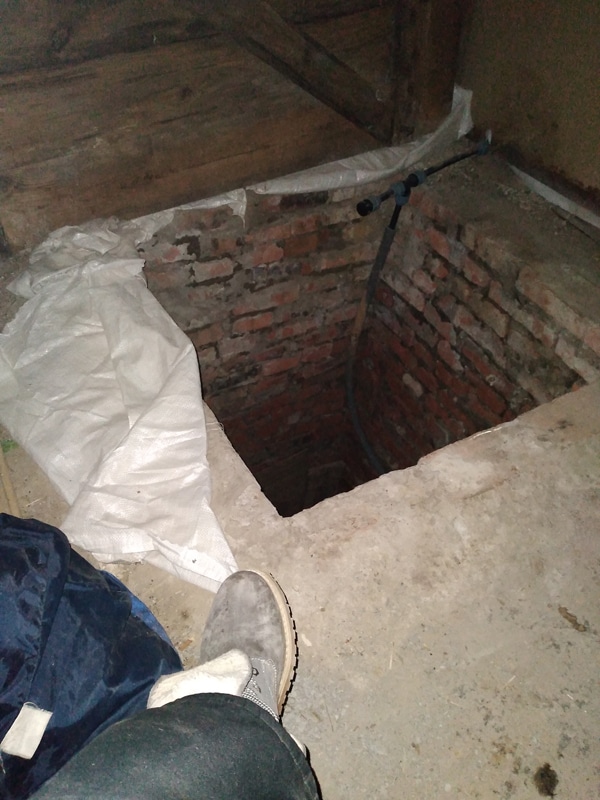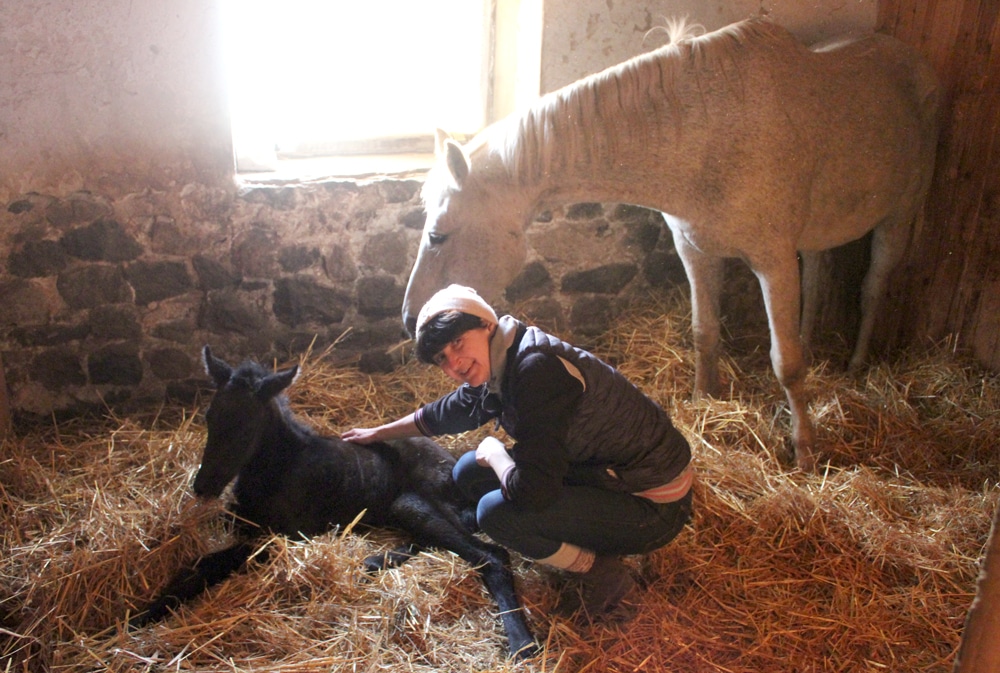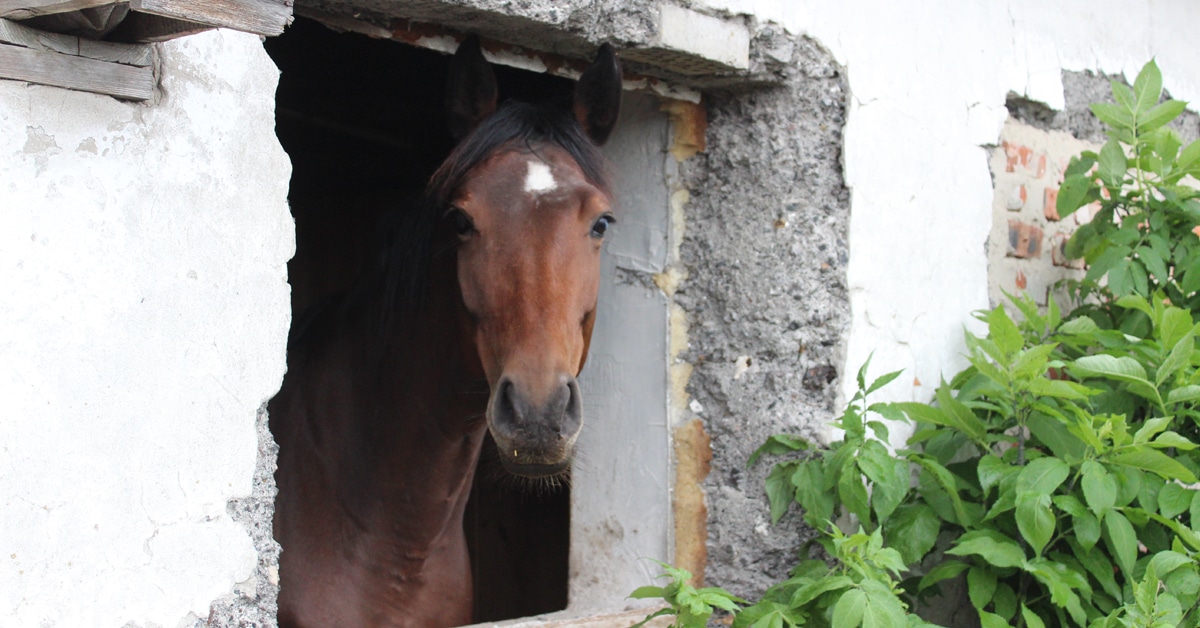The war in Ukraine is progressing with no end in sight (read part one of this series here). The Russian army continues to fire missiles and for those who manage to survive the onslaught, the horrific memories can cause nightmares, anxiety, depression, irritation, anger, and auditory and visual hallucinations. Images of terror play themselves over and over again and a large percentage of survivors may never recover from Post Traumatic Stress Syndrome (PTSD). For people with this condition, it only takes small triggers for it to return and haunt their waking lives.
However, humans aren’t the only ones who re-experience the hell of war long after it’s been won or lost. Experts believe horses also suffer from PTSD. Recently, I had the chance to speak with a woman who is trying to survive the war in Ukraine, but believes she and her horses are suffering from PTSD.
Maria’s Story
Maria Sergienko, 49, is a mother and the owner of a small horse breeding stable near Chernihiv in northern Ukraine. Prior to the the war she was a successful advertising exec, vice-president of management for the largest Ukrainian municipal children’s equestrian school, and former president of the Regional Equestrian Federation. Her family sold all of their possessions, their three-room apartment, and also borrowed money to purchase their own dream stable six years ago.
Maria recalls the night they were attacked. “On February 28, we were all in the stable. The shelling just started out of nowhere. There were minutes of continuous explosions which could be heard everywhere.” She and her 16-year-old son fell to the stable floor. “In the meadow, all our horses, of which five are broodmares, ran in all directions as shells exploded around them. They somehow, some way, stayed alive.”

Destruction of homes in the Chernihiv area.
The first days the Russians began shelling were terrible. Maria tried to calm herself down, hoping the horses would imitate her behaviour and not be nervous. During the day the horses were kept outside in the meadow; at night they resided in stalls inside the stable. Maria and her family were lucky during the first shelling: only the fence and the stable were damaged. “The mare Melody, who arrived that day from another stable, was terrified of the shelling. In the darkness, this mare was beating against the walls and screaming loudly. She broke the stall and scared the other horses.”
They had no electricity for more than a month, so her family survived thanks to a gasoline generator they purchased the day before the war started. During that month of continuous shelling her family hid in a “1.5 x 1.5 meter, 2.5 meter deep pit near the horses’ water pump.
Maria still has nightmares today about the conditions they endured. “We slept in a pit. There were four of us. It was the middle of winter. The family froze. There was no food. Shops were closed throughout the village on the first day of the war. There was no sugar, bread, cereal or toilet paper. Inside the pit it was awful. All we could do was pray.”

The ‘pit’ where Maria’s family took refuge.
Maria’s husband, equestrian coach Serhiy Sergienko, has trained five champion horses in Ukraine in three different equestrian disciplines. “We have been together for over 16 years. Since my husband is also a zoo technician/breeder, I was lucky to be involved in the planning and birth of more than 300 breeding horses.”
Maria and her family quickly learned to distinguish explosions, shots from tanks, mortars, and self-propelled units. At one point, a Russian military plane was shot down over her farm. Three soldiers from reconnaissance and sabotage groups approached her family. “When the enemy soldiers came, we did not know that they were enemies. They were dressed in military uniforms of Ukrainian soldiers. They seemed worried and scared. Although they came with machine guns, they wanted to find a car. We went into the stable and I called the head of the village and the boys from the defense. After fifteen minutes our soldiers arrived and arrested the Russians.”
Maria’s family didn’t know whether to put the horses in the stable at night or leave them outside. Their friends had three horses who were killed in the first night of the bombings. Later their friends who went to serve in the territorial defense brought back food which saved Maria’s family and prevented the horses from starving to death. “They also brought us their dog and four of their horses. Now we have twenty-four horses, five dogs and three cats.”

Despite the shelling and terror, Maria was relieved to welcome five healthy foals.
Despite all the shelling, Marie feels luckier than some. All the farms next to Maria’s were affected. One stable was completely destroyed, and another partially damaged. “Two of my friends’ horses kept in the stable that was bombed died.
“We have broken windows, a damaged roof and some cluster munitions and mines that did not explode. We were so fortunate. Our family and horses survived and five foals were born. These are breeding horses with incredible sport pedigrees.”
Another problem is that farmers are afraid of cutting their hay fields. “Our neighbours’ tractor was hit and exploded. The driver died.”
One night after the second shelling Maria and her husband stayed with friends. “At the time we were leaving, the road was shelled. Many people died. Bodies were strewn everywhere. It was something incomprehensible. It kept me in the stable. I couldn’t stop shaking.”
PTSD and Horses
Dr. Joe Waldman DVM is the co-owner of Calgary’s oldest veterinary practice in Calgary, Alberta, and is the past president of the Calgary Academy of Veterinary Medicine. I recently had a chance to discuss PTSD in Ukraine horses with him.
After hearing Maria’s story, he pointed out it was likely both Maria and her horses were experiencing if not PTSD, then heightened anxiety. In a situation where both the owner and horses were suffering, he wasn’t sure if the owner would be able to effectively help the horses rehab.
“What we’re talking about here is trauma. If a horse grew up in a good home and was well cared for, the trauma of war could cause extreme anxiety and possible post traumatic stress syndrome.”
He explained that horses suffering from PTSD will have a heightened reaction to ‘triggers’ which may have been prevalent during wartime. For example, loud sounds emulating the sound of a bomb, missile or gunfire might cause the horse to react in a unconventional way or trigger unstable behaviour.
Dr. Waldman emphasized, “If your horse normally responds to a loud sound with a ‘two out of 10’ reaction and after the war it’s a nine out of 10, it’s likely they’re suffering from PTSD. Some horses might actually shut down emotionally, others might have a fight-or-flight reaction, while a percentage could go into attack mode.”
In terms of treatment, Dr. Waldman feels there’s always a place for medication, depending on the circumstances. “If a horse is being shipped to a different location [such as during an evacuation] and reacts in attack mode, it may need medication for that particular situation, just like a human might need medication for flying.”
Overall, Dr. Waldman feels one of the key rehab tools for helping a horse normalize may be desensitization therapy. “For instance, loud sounds might put your horse into attack mode. It that case it may be prudent in your sessions to start off with a quieter loud sound and over the weeks keep raising the volume.”
He also insisted it’s integral to ensure your horse feels in control of his environment. If the majority of their triggers are happening outside, then it’s critical to initially keep the horse inside the barn. “We need to gradually re-expose them to the triggers through different therapies which may be helpful. If the horse isn’t responding to the different types of therapy and his reactions to triggers become dangerous to others, the owner may have a very difficult choice to make. For some owners that might mean putting their horses down.”
Ultimately Maria and her horses have a very difficult journey ahead of them. However, if she can find them the appropriate help and work with the horses every day, as well as seeking therapy herself, there is always hope.

